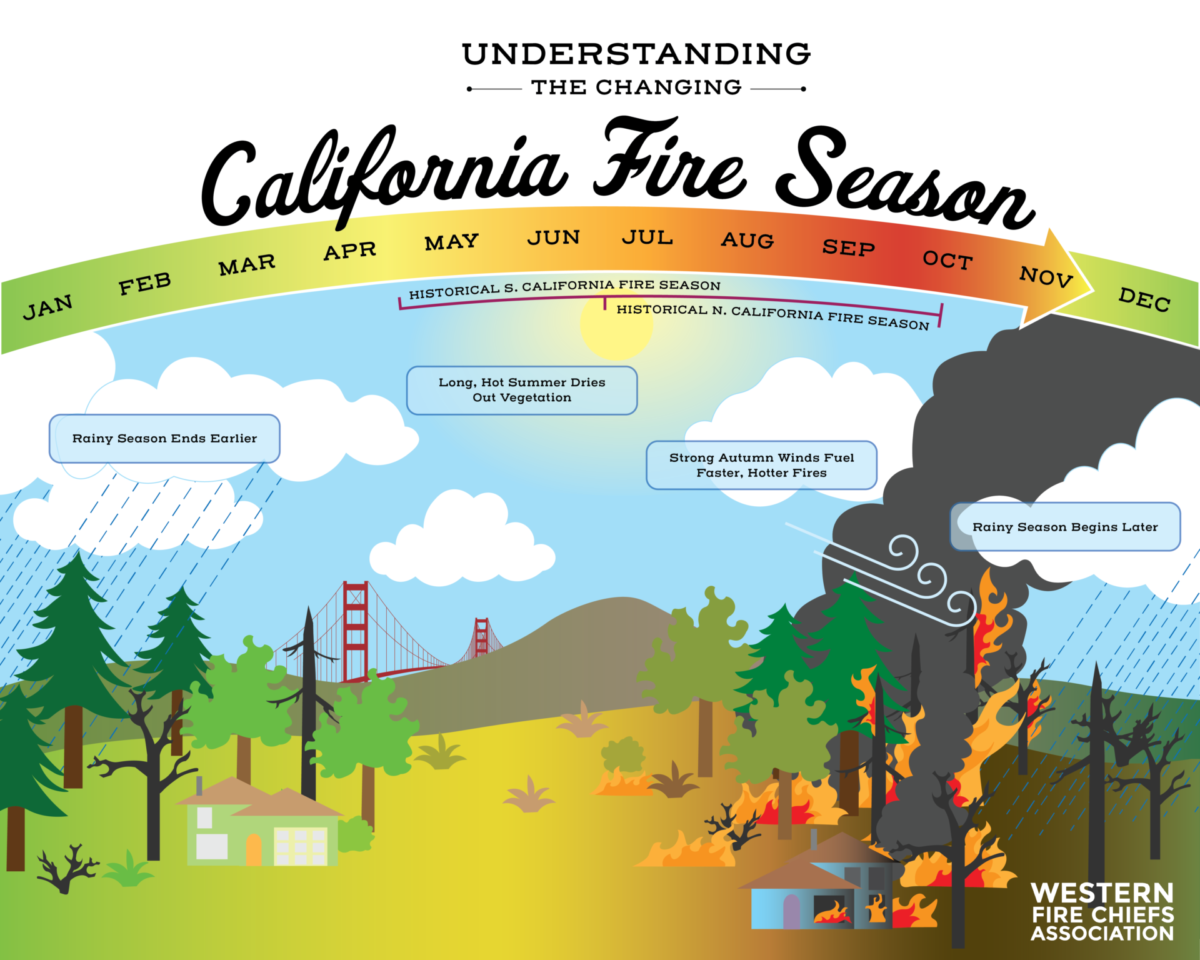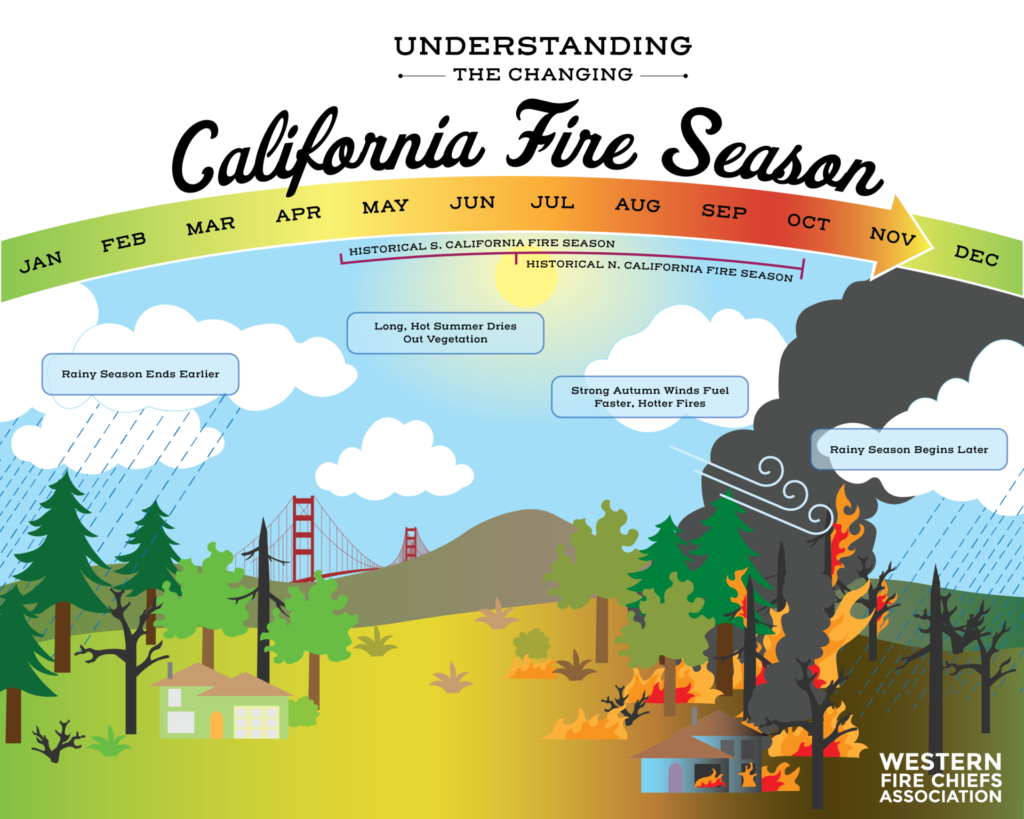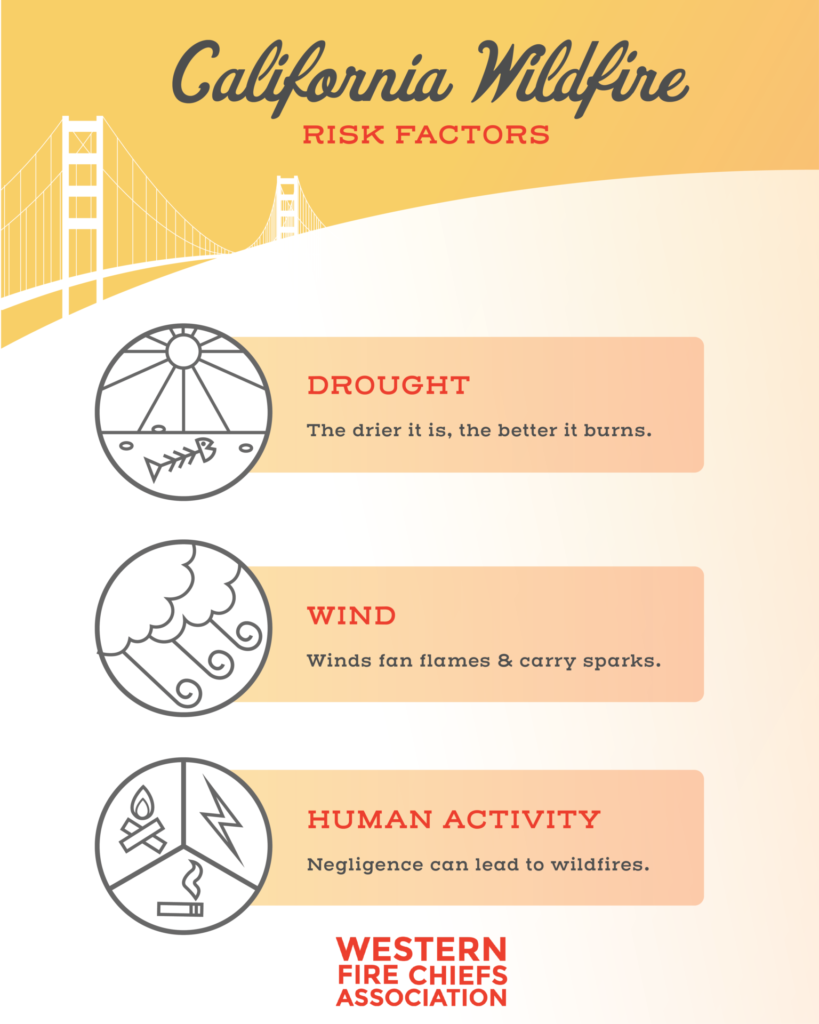Firework Safety Tips: How to Stay Safe
Discover essential firework safety tips to ensure a dazzling display without accidents. Learn how to celebrate responsibly with expert guidance from WFCA.
Explore the details of the California fire season with insight from the Western Fire Chiefs Association (WFCA). Learn when is it, how long it lasts, risk factors and more.
Published:July 5, 2022
Edited:March 4, 2024

In this guide, the Western Fire Chiefs Association (WFCA) answers common questions about the California fire season, including how long it lasts, its risk factors, and more.

Fires are possible throughout the year in California, but the peak fire season in Northern California usually begins in June or July and runs through late October or November. However, the Southern California peak fire season starts earlier, beginning in late spring (May-June) and runs until October.1
It is a common misconception that the most dangerous time for fires in California is during July and August. While there may be fewer fires in September and October, the fires that do occur are far more destructive and burn through many more acres. This explosive effect is due to a combination of dry vegetation from hot summer weather, and intense dry winds that blow through the state during fall.
The length of the fire season in any given year in California depends on summer temperatures, rainfall, and wind, with the most fires historically occurring between May and October. However, recent data show that, due to rising temperatures and decreased rainfall, the season is beginning earlier and ending later each year, approaching a year-round fire season.1
The fire season in California tends to end once the state receives heavy rainfall. However, the impacts of climate change mean that fall precipitation is often delayed, which can keep fires burning throughout the winter months.
Since wildfire thrives in hot and dry climates, drought elevates fire risk significantly. Drought leaves trees, grasses, shrubs, and soil with very little moisture, making the landscape extremely flammable.
Likewise, ongoing droughts in California pose a serious threat for fire season. A recent report by the US Drought Monitor found more than 97% of the state is in severe or extreme drought, causing concern for the year ahead.2
When winds are paired with hot, dry weather, they pose a major fire hazard. For example, the Santa Ana winds in Southern California (also known as Diablo winds in Northern California) are strong, dry, downslope winds that blow from the mountains towards the coast and can cause wildfires to ignite and spread rapidly. Consequently, these winds reach up to 40 miles per hour and in some cases can reach up to hurricane strength, exponentially increasing in the speed of fire spread and triggering extreme destruction in short amounts of time.
As much as 90% of wildfires are started by humans.3 Common reasons for wildfire ignition include unattended campfires, fallen power lines, discarded cigarettes, vehicle crashes or the use of equipment that creates sparks, like metal grinders.

Climate change is having a serious impact on the prevalence of wildfires in California. The changes in climate are creating warmer, drier seasons, which are the ideal conditions for fires to burn. Not only does this increase the frequency of fires, but also increased the severity and amount of damage done.
Additionally, decreased rainfall means that vegetation remains dryer and more flammable into the late fall and winter months, increasing the likelihood of extreme, late-season wildfires.
According to the incident stats from CAL FIRE, in 2021, a total of 8,835 fires were recorded across the state of California, burning a total of 2,568,948 acres.4 There were approximately 3,629 structures damaged or destroyed by the wildfires last year.4
The 2020-21 drought has had a significant impact on California’s fires. Very dry winters followed by arid, hot summers have left soil and vegetation extremely dry and vulnerable to fires.
Even though peak wildfire season has not yet begun (as of April 2022), there have been a number of wildfires across Northern and Southern California so far.
| Colorado Fire Date: 1/21/2022 County: Monterey Acres burned: 687 Containment: 100% | Emerald Fire Date: 2/10/2022 County: Orange Acres burned: 154 Containment: 100% |
| Airport Fire Date: 2/16/2022 County: Inyo Acres burned: 4,136 Containment: 100% | Alpine Fire Date: 3/1/2022 County: Sonoma Acres burned: 21 Containment: 100% |
| Jim Fire Date: 3/2/2022 County: Orange External Incident Link | Flanagan Fire Date: 3/4/2022 County: Shasta Acres burned: 88 Containment: 100% |
| Hollister Fire Date: 3/12/2022 County: Santa Barbara Acres burned: 120 Containment: 100% | Gulch Fire Date: 3/12/2022 County: Siskiyou Acres burned: 113 Containment: 100% |
| Evergreen Fire Date: 3/12/2022 County: Siskiyou Acres burned: 12 Containment: 100% | Whitlow Fire Date: 3/25/2022 County: Siskiyou Acres burned: 10 Containment: 100% |
Utilize WFCA’s Fire Map to search for the status of an active wildfire in California. Users can zoom in and select each individual fire to get instant access to the latest published information.
Continuing to examine the history of California wildfires, a key trend that emerges is the lengthening of the season. With fires happening throughout the winter months, a year-round fire season is swiftly becoming the norm.
A drier and hotter climate isn’t just increasing the frequency of wildfires in California, it makes them harder to fight due to their increased size and intensity. Eight of the state’s ten largest fires on record—and twelve of the top twenty—have happened within the past five years. In 2020 alone, five of California’s top 20 biggest wildfires occurred.5
Further stats from the CAL FIRE incident archive show that in 2020, wildfires damaged or destroyed 4.3 million acres of land, over 11,000 structures, and cost the lives of 33 people.6
Two recent incidents, the Dixie Fire (2021) and the August Complex (2020) in Northern California have been noted for their sheer size – each burning nearly 1 million acres and raging for months. Particularly, the August Complex is California’s largest recorded wildfire and has been described as the world’s first ‘gigafire’, destroying over 1 million acres and more than 900 structures.5
Lastly, 13 of California’s 20 most destructive wildfires have occurred in the past five years; collectively destroying 40,000 homes, businesses, and pieces of infrastructure. Learn about the causes of wildfire, and how you can help to harden your home against wildfire and creating Firewise® site.
Discover essential firework safety tips to ensure a dazzling display without accidents. Learn how to celebrate responsibly with expert guidance from WFCA.
Explore the role of AI in wildfire prediction with guidance from the WFCA. Learn how advanced algorithms and data analytics enhance early detection and response.
Empower your community with a detailed guide on creating a Wildfire Protection Plan. Explore crucial steps and strategies with expert guidance from the WFCA.